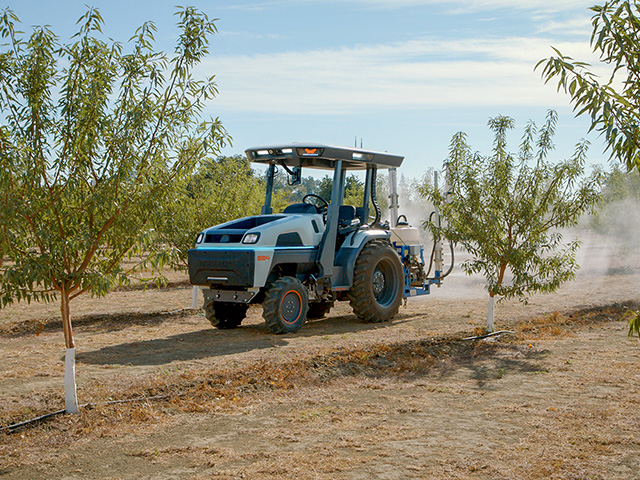Monarch Deploys First Tractors
Monarchs Bring AI, Machine Learning to Wente Vineyards
Smart-tractor manufacturer Monarch Tractor has moved a pair of its fully electric, driver-optional tractors to Wente Vineyards, the oldest, continuously operated family winery in the United States. The Monarch tractors represent the California-based manufacturer's first commercial deployment of its tractor, now in development for 2 1/2 years.
"We've seen firsthand the benefits of the Monarch tractor in our vineyards," said Niki Wente, a fifth-generation grower and senior vineyard and viticulture manager. "Monarch Tractor represents the future of tractors. To be the first customer deployment is especially exciting as we kick off this new era of sustainable farming."
Wente Vineyards, founded in 1883, today tends 2,600 acres of vineyards in California's Livermore Valley and Monterey appellations. The operation is certified sustainable by the state of California. "We've always been interested in new technologies, especially those that contribute to our sustainability," Wente told DTN/Progressive Farmer.
While California law regulates the use of autonomous tractors beyond research, Wente is convinced full, driverless operations are coming for machines like the Monarchs.
"Autonomy is 100% something I believe will be a game changer. I'm excited about that part." Wente sees immediate use for autonomous Monarchs in production agriculture, such as autonomously towing grape gondolas from harvesters to trucks for transportation.
With its camera systems and artificial intelligence capabilities, "This tractor also could become my next field scout," Wente explained. "(The Monarch) can tell you what's going on within a vineyard block, what insects are feeding there or what virus that might be; alert me when something doesn't look right and pinpoint it on a GPS map."
Praveen Penmetsa, CEO of Monarch Tractor, said the Wente operation shows faith in the product. "When you're running a 3,000-acre farm, it can't be just about sustainability, (the tractor) also has to add to the bottom line," Penmetsa said in an interview with DTN/Progressive Farmer. "The fact that one of the oldest (vineyard) families are getting our tractors, the fact that they value the farm economics side as well as the sustainability side ... is all very exciting."
Both of the Wente Monarchs will begin their lives performing mowing chores. It's necessary work that also will provide operators with experience in managing the machines. The manufacturer said the compact utility Monarch cuts operating costs by $45 per operating day compared to similar-sized diesel tractors.
"Our tractor has undergone strenuous real-world testing and is now ready to get to work and deliver on the promise of a more sustainable and efficient farming operation," Penmetsa said.
P[L1] D[0x0] M[300x250] OOP[F] ADUNIT[] T[]
Monarch said that its electric smart tractor automates not only tractor operations, but farming operations. A Monarch tractor is essentially a data collection hub, analyzing 240 gigabytes of crop data every day it operates. It has the ability to transmit crop health observations to remote managers. With machine learning capabilities, it performs functions such as spraying or cultivating. The Monarch can haul supplies like a side-by-side utility vehicle, function as an in-the-field drone for recharging other units, or supply power for repair and maintenance work such as welding.
The Monarch creates alerts and provides actionable information for managers. For example, the Monarch incorporates a micro weather station that, among climatic conditions, monitors wind speed. The platform ceases spraying operations if local wind conditions exceed either preplanned or regulatory parameters.
Here are manufacturer specifications for the Monarch:
-- The Monarch looks like a compact tractor, narrower than a compact, but slightly longer.
-- Its electric drivetrain provides 40 horsepower (30 kilowatts) of continuous power and short-duration peak power up to 70 hp (55 KW).
-- The PTO and three-point hitch are comparable to a diesel tractor.
-- It's hydraulic capacity equals or exceeds conventionally powered units of the same size.
-- Because it is electric, the Monarch has two times as much torque as comparable units.
-- The Monarch runs on a large battery with 10 hours or more of operating time. Under high workloads, the battery is designed to give owners four to five hours of operation. A battery recharge requires up to five hours. To manage charging time, Monarch sells an optional swappable battery pack.
Compact utility tractors are a fast-growing segment in the U.S., where compact units are typically used more than 100 days per year. Monarch Tractor ($50,000 for the tractor, $15,000 for a spare battery pack) eyes an annual worldwide market of 1.4 million to 1.5 million units.
Monarch's Livermore, California, assembly facility is beginning to fill preorders for customers in California, Oregon and Washington -- one customer ordered five. Monarch tractors will be shipped generally to vineyard, orchard and blueberry operations.
Monarch Tractor's deployment is due in part to the California Air Resources Board's Farming Agricultural Replacement Measures for Emission Reductions (FARMER) program. The FARMER program offers grants for Advanced Technology Demonstration Projects, an initiative leading to a grant offered to Monarch Tractor.
To see the Monarch Tractor in action, watch this video: https://www.youtube.com/….
To learn more about Monarch Tractor, visit www.monarchtractor.com.
To see past coverage of the unveiling of the tractor, see https://www.dtnpf.com/….
To see how the tractor has attracted global investments, see https://www.dtnpf.com/….
Dan Miller can be reached at dan.miller@dtn.com
Follow him on Twitter @DMillerPF
(c) Copyright 2021 DTN, LLC. All rights reserved.




